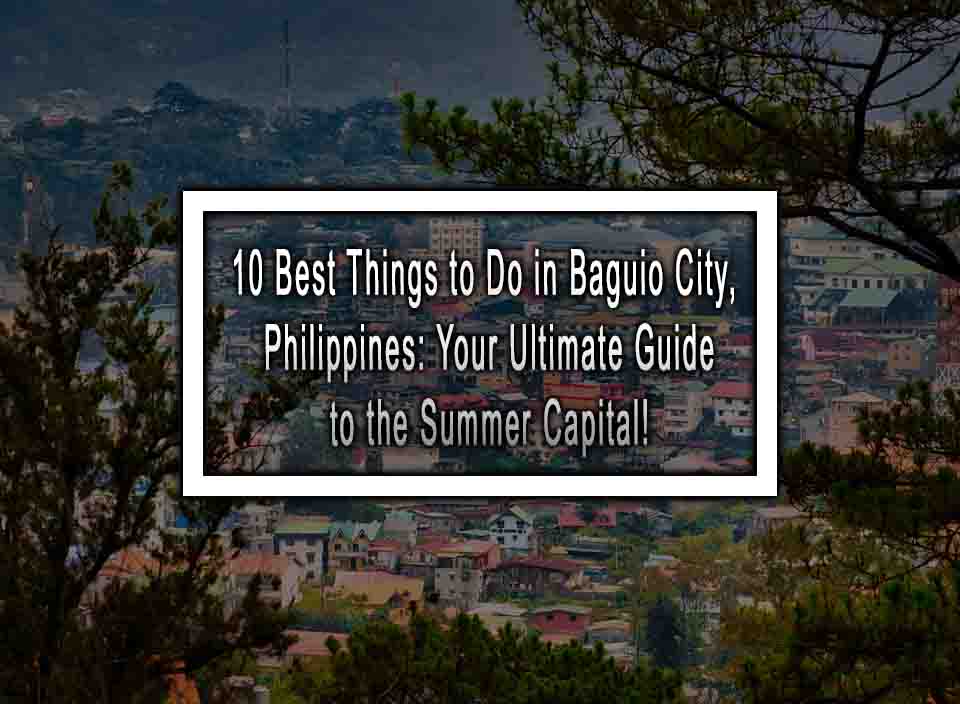Pack Your Bags and Your Sweater: It’s Time for a Baguio Adventure!
Tucked away in the mountainous regions of Northern Luzon, Baguio City beckons travelers with its cool climate, fragrant pine trees, and vibrant culture. Known as the “Summer Capital of the Philippines,” it’s a haven for those looking to escape the tropical heat. But Baguio isn’t just a place to chill; it’s also bursting with activities that cater to every kind of traveler. From foodies and art aficionados to nature lovers and adrenaline junkies, there’s something in Baguio for you. So, dust off your coziest sweater, and let’s discover the top 10 things you absolutely must do when in Baguio City!
1. Enjoy a Stroll at Burnham Park
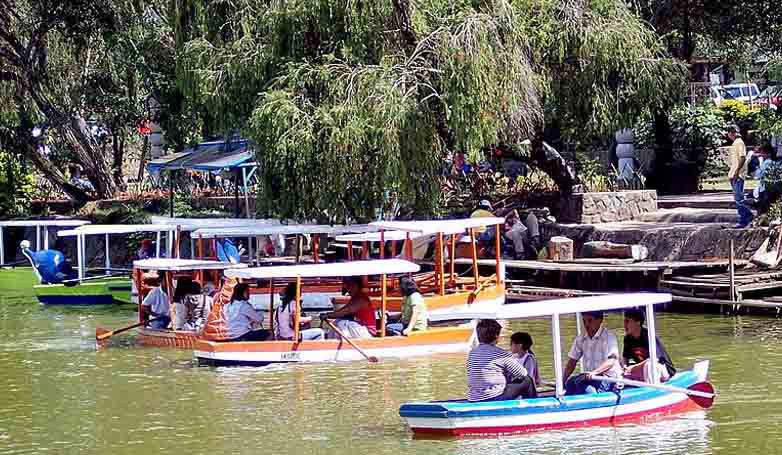
Burnham Park is the heart of Baguio City, serving as its most iconic and beloved public park. Named after the American architect Daniel Hudson Burnham, who laid the foundations for Baguio’s urban design, the park spans approximately 32.84 hectares and is a serene respite from the city’s bustling environment. A centerpiece of the park is a man-made lake where visitors can enjoy boat rides. With its cool climate, lush gardens, bike trails, and picnic spots, Burnham Park exudes charm that captivates both locals and tourists. Throughout the year, the park is a hive of activity, hosting events, cultural shows, and a favorite spot for exercise and family outings.
Trivia
- The park was officially named Burnham Park in 1925, in honor of its planner and architect, although it was already in use prior to this official designation.
- The Melvin Jones Grandstand, located within the park, is a usual venue for large-scale events such as the Panagbenga Festival’s grand parades.
- The park features the Burnham Rose Garden, boasting a variety of roses, adding to the city’s moniker as the “Summer Capital of the Philippines.”
2. Visit the Iconic Lion’s Head
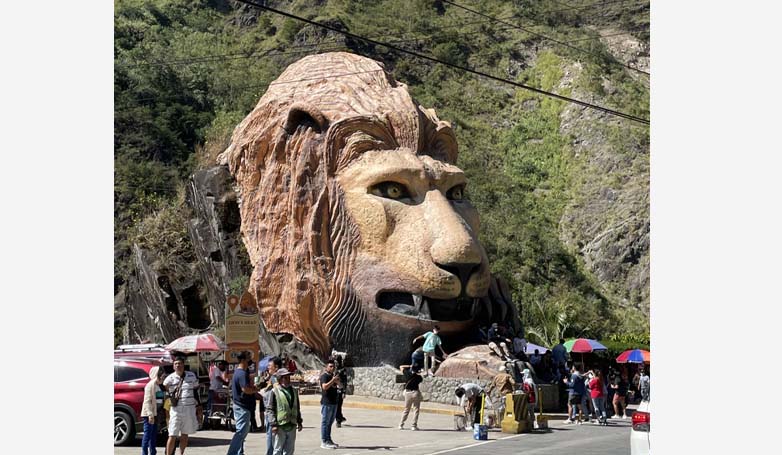
Lion’s Head is a prominent tourist attraction on the way to Baguio City in the Philippines. This massive stone statue stands at 40 feet high and is a representation of the mighty lion, carved directly into a boulder located along Kennon Road. It was commissioned in the 1970s as a symbol of Baguio, known as the “Summer Capital of the Philippines” due to its cooler mountain climate. The artistic work was executed under the direction of Ifugao artists, thus integrating local cultural elements into the monument. Over the years, the Lion’s Head has become an iconic stopover for travelers, providing a unique photo opportunity. The site is often bustling with tourists and souvenir vendors, adding to its vibrant atmosphere.
Trivia
- The creation of the Lion’s Head was initiated by the Lions Club of Baguio City.
- Local legends suggest that touching the nose of the lion’s head brings good luck.
- The Lion’s Head is situated approximately 2,000 feet above sea level.
3. Explore the BenCab Museum
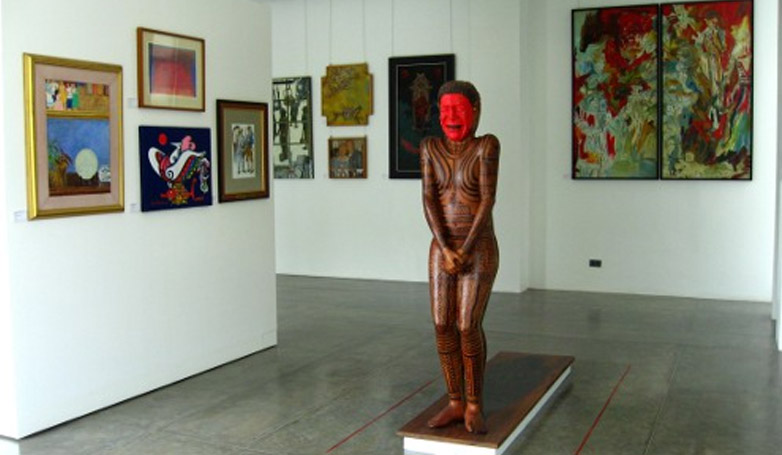
Nestled in the highlands of Baguio City, the BenCab Museum stands as a testament to the creative spirit of the Cordilleras and the Philippines. Established by National Artist Benedicto Cabrera, famously known as BenCab, the museum offers an extensive display of his artworks and personal art collection. Visitors can explore galleries featuring Philippine indigenous art, contemporary exhibits, and craft workshops. The museum is spread across multiple levels, surrounded by verdant gardens that offer panoramic views of the lush landscape. BenCab Museum also includes a farm and cafe, promoting sustainable living and providing an immersive cultural experience for art enthusiasts and eco-tourists alike.
Trivia
- The BenCab Museum celebrates its founding artist’s 50 years of contribution to Philippine art.
- It houses the Erotica Gallery, showcasing artworks that explore human sexuality and sensuality.
- A unique feature of the museum is the “Bulol” installation, consisting of traditional rice granary gods from the Cordillera region.
4. Indulge in Strawberry Picking at La Trinidad
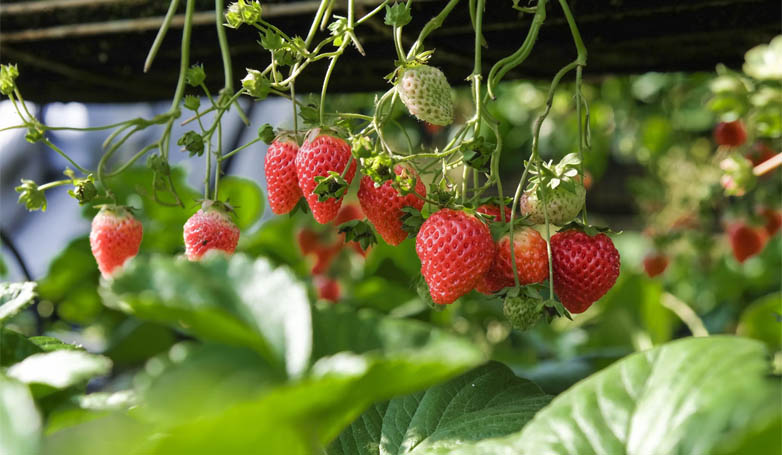
Strawberry picking is a delightful activity that allows individuals to experience the joy of harvesting fresh strawberries straight from the field. It’s a popular agritourism attraction in various parts of the world, offering a hands-on approach to understanding where our food comes from. One such place known for this activity is Baguio City, located in the Philippines. In Baguio, the cool climate is conducive to growing sweet and juicy strawberries, making it a prime location for strawberry farms. Visitors get to wander through rows of strawberry plants, enjoying the scenic view while selecting the ripest berries to fill their baskets. It’s both a fun and educational experience, ideal for families and anyone with a love for fresh fruit and nature.
Trivia
- Strawberries are the first fruit to ripen each spring.
- Strawberries are not actually berries in the botanical sense; they are considered aggregate accessory fruits.
- Strawberries are unique among fruits as they wear their seeds on the outside, with each strawberry having approximately 200 seeds.
5. Wander Around Camp John Hay
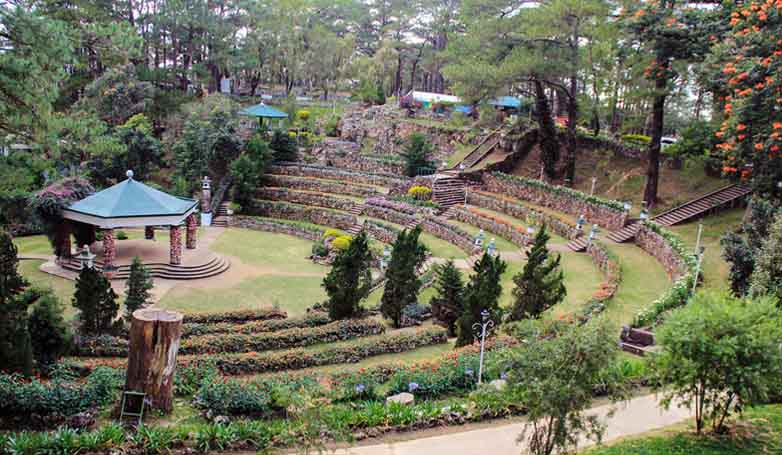
Camp John Hay is a historical site nestled in the cool and lush landscapes of Baguio City, the Philippines’ summer capital. Sprawling over 690 hectares, this former rest and recreation facility for U.S. military personnel exudes a blend of American colonial architecture and native Igorot influence. Today, Camp John Hay has transformed into a premier destination for tourists, offering a luxurious hotel, the Manor, a well-manicured 18-hole golf course, scenic picnic areas, and trails enveloped in pine trees. Visitors can indulge in various activities like horseback riding, mini-golf, and treetop adventures. Amidst the natural beauty, the site also provides a shopping center and dining options, ranging from casual cafes to fine dining.
Trivia
- Camp John Hay was established in 1903 and named after U.S. President Theodore Roosevelt’s Secretary of State, John Milton Hay
- During World War II, it served as a concentration camp for Americans and other civilians under the Japanese Imperial Army.
- In 1991, the Philippine government officially acquired Camp John Hay through a lease agreement with the U.S. government.
6. Revel in the Colors of Panagbenga Festival

The Panagbenga Festival is a month-long annual flower festival occurring in Baguio City, Philippines. Celebrated every February when flowers are in bloom, it showcases the rich cultural heritage, history, and blooming economy of the city, also known as the “Summer Capital of the Philippines.” Its name means “season of blooming,” and true to this, the festival features vibrant floats covered in a myriad of fresh flowers and street dancers adorned in floral costumes. The colorful parades and competitions, including the Grand Street Dancing Parade and the Grand Float Parade, are the festival’s highlights, drawing local and international tourists. The festival also includes garden tours, exhibitions, and a fireworks show, making Baguio City alive with energy and color.
Trivia
- The Panagbenga Festival was created as a way to rise above the devastation following the 1990 Luzon earthquake.
- It was first held in 1996 and has since become a major part of Baguio City’s identity and tourism.
- The floats featured in the Grand Float Parade are made with flowers and plants that are locally grown in and around Baguio City.
7. Savor the Flavors of Session Road

Session Road in Baguio City is an iconic street at the heart of the Philippines’ summer capital, bursting with a kaleidoscope of flavors that mirror the city’s vibrant cultural heritage. This bustling boulevard is a food enthusiast’s haven, offering an array of dining options from cozy cafes, specialty restaurants, and street food stalls. The cool climate enhances the experience of savoring steaming bowls of Bulalo or sipping on the region’s famed Arabica coffee. The mix of international cuisines and local Igorot dishes provides a taste adventure that is as diverse as the people walking its sloping pavement. Whether you’re looking for finely baked goods or the freshest strawberry concoctions, Session Road is the gastronomic centerpiece of Baguio City.
Trivia
- The name “Session Road” comes from the fact that it was the main thoroughfare to the old Baden-Powell Hall, where the first Philippine Commission held sessions in Baguio.
- Once a year, during the “Session Road in Bloom” event, the roadway is closed to vehicles and transformed into a pedestrian-only area with food stalls and live music, highlighting the city’s community spirit.
- It’s famous for its second-hand bookstores and ukay-ukay (thrift shops), which offer a hunt for rare finds and vintage treasures.
8. Experience Thrills at Tree Top Adventure
Zip-lining in Baguio City offers an exhilarating experience that attracts thrill-seekers and nature enthusiasts alike. This high-altitude activity allows adventurers to soar above scenic landscapes, providing breathtaking views of Baguio’s lush greenery, rolling hills, and cool climate. The zip line facilities are designed with safety in mind, harnessing riders securely to ensure a fun-filled journey across the sky. Multiple zip line lengths cater to different levels of daring, appealing to both novices and experienced zipliners. The inclusion of professional instructors ensures a memorable and safe experience. The unique blend of excitement, panoramic vistas, and crisp mountain air makes zip-lining in Bagio City a must-try activity for tourists and locals.
Trivia
- The longest zip line in Baguio spans over 400 meters, offering a thrilling ride for several minutes.
- Zip line operators in Baguio often use a dual-cable system to ensure maximum safety and stability.
- Baguio’s zip line attractions are situated at different elevations, some exceeding 5,000 feet above sea level, offering not just a fun activity but also an incredible high-elevation viewpoint.
9. Reflect at The Lourdes Grotto

The Lourdes Grotto is a revered Catholic shrine situated in Baguio City, Philippines. This serene sanctuary, perched atop a hill, features a zigzagging staircase with 252 steps leading up to a statue of the Virgin Mary, mirroring the grotto in Lourdes, France, where believers state the Blessed Mother appeared to Saint Bernadette Soubirous in 1858. Known for its peaceful ambiance, the Lourdes Grotto is a place of prayer, reflection, and pilgrimage, especially during Holy Week. Visitors and devotees climb the steps, often saying prayers as they go, to light candles and seek blessings at the grotto. The panoramic view of Baguio City and the cool mountain air add to the spiritual and calming experience.
Trivia
- The Lourdes Grotto was built by the Jesuit Fathers of Baguio City in 1907.
- On February 11, the anniversary of the apparitions of the Virgin Mary at Lourdes, France, special celebrations are held at the grotto in Baguio.
- It’s believed that the holy water at the Lourdes Grotto in Baguio possesses healing properties, much like the water in the French Lourdes.
10. Shop at the Baguio City Market
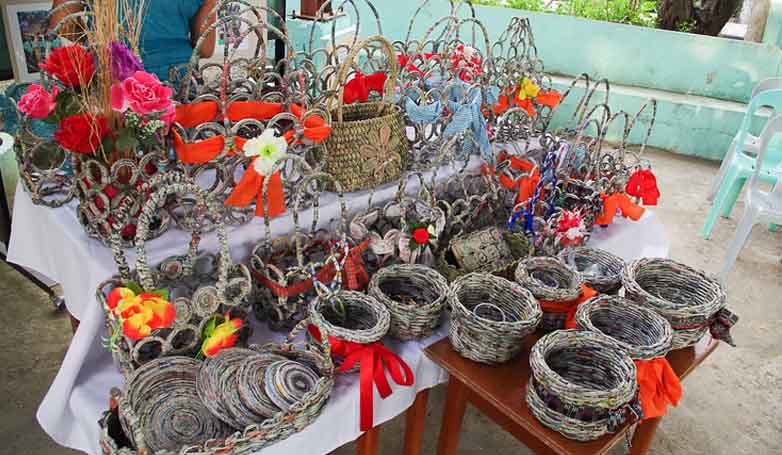
Located in the heart of Baguio City, the Baguio City Market is a vibrant and bustling hub that captures the essence of local trade and culture. This market offers a vast array of goods ranging from fresh produce, such as strawberries and vegetables that thrive in the city’s cool climate, to handcrafted souvenirs like woven fabrics and woodcarvings symbolic of the region’s arts and craftsmanship. Within its lively alleys, visitors can also discover an assortment of flowers, uniquely flavored jams and preserves, and a diverse selection of meat and dairy products. The market’s friendly vendors and the colorful display of goods contribute to an authentic and enjoyable shopping experience, reflecting Baguio City’s rich heritage and warm community spirit. Here are some Filipino handicrafts you can love.
Trivia
- The market is also famous for selling ‘pasalubong’ items like peanut brittle and ube jam, favorites among tourists for bringing back home.
- Every weekend, a portion of the market is transformed into the “Weekend Market,” where even more vendors set up shop to sell a broader range of handcrafted items and street food specialties.
- Baguio City Market has a rich history dating back to the American colonial period, evolving from a simple marketplace to a landmark of the city’s culture and economy.
Say Goodbye to Baguio with a Heart Full of Memories!
From the lush greenery of its parks to the rich tapestry of culture and art, Baguio City offers an array of unforgettable experiences. As you say goodbye to this mountain haven, you’re not just leaving with souvenirs, but also a heart full of memories and stories to tell. This list of ten must-do experiences is just the beginning – the Summer Capital of the Philippines has so much more waiting for you to explore. So whether you’re savoring the local flavors, engaging with the vibrant culture, or simply enjoying the cool breeze, Baguio City is a destination that will always welcome you back with open arms and a warm smile. Don’t wait too long to return to Baguio’s charming embrace!
Baguio City FAQs
Here are the most common questions about the Baguio City.
1. What is the local language in Baguio City?
The local languages in Baguio City are Ilocano and Kankana-ey, but Filipino (Tagalog) and English are widely spoken and understood, making communication with locals easy for most tourists.
2. What is the best time to visit Baguio City?
The best time to visit Baguio City is from November to May, when the weather is dry, making it easier to explore and enjoy outdoor activities. December to February offers the coolest temperatures, while the Panagbenga Festival in February is a peak time for visitors.
3. How do you get to Baguio City?
Baguio City is accessible by road. It’s approximately a 4-6 hour drive from Manila depending on traffic conditions and the route taken. Public transportation options include buses, with several companies operating direct services from Manila to Baguio.
4. What is the climate like in Baguio City?
The climate in Baguio City is subtropical highland, which means it is cooler than most places in the Philippines. Temperatures average from 15 to 23 degrees Celsius. The city experiences a wet season and a dry season, with heavy fog common during the rainy period.
5. Can I drive to Baguio City?
Yes, you can drive to Baguio City. The most common route from Manila is via the North Luzon Expressway (NLEX), transitioning to the Subic-Clark-Tarlac Expressway (SCTEX), and then taking the Tarlac-Pangasinan-La Union Expressway (TPLEX) to reach Baguio. There are alternate routes via Marcos Highway or Kennon Road, but it’s important to check their accessibility as they are sometimes closed for maintenance or due to weather conditions.

